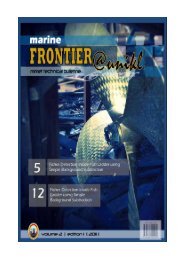click here to download - UniKL MIMET Official Website
click here to download - UniKL MIMET Official Website
click here to download - UniKL MIMET Official Website
You also want an ePaper? Increase the reach of your titles
YUMPU automatically turns print PDFs into web optimized ePapers that Google loves.
LEGAL REQUIREMENTS AND CONSTRAINTS<br />
In ensuring safety of chemical tankers at<br />
sea, ship builders and ship owners need <strong>to</strong> ob‐<br />
serve all legal requirements imposed through<br />
various conventions and codes by the Interna‐<br />
tional Maritime Organization (IMO). This will en‐<br />
able their ships meet the qualification for the<br />
award of a certificate of Class for Hull and Ma‐<br />
chinery issued by designated classification socie‐<br />
ties. The IMO divides chemical tanker in<strong>to</strong> three<br />
(3) groups namely vessels designed <strong>to</strong> carry the<br />
most hazardous cargo; vessels designed <strong>to</strong> carry<br />
less hazardous cargo than the first; and the ves‐<br />
sels designed <strong>to</strong> carry the least hazardous chemi‐<br />
cals (ICS, 2002). Among IMO’s conventions, the<br />
International Convention for the Prevention of<br />
Pollution from Ships, 1973 (MARPOL) and the<br />
International Convention for the Safety of Life at<br />
Sea, 1974 (SOLAS) are the most important trea‐<br />
ties implemented <strong>to</strong> ensure the safety of chemi‐<br />
cal tankers.<br />
The main criterion for the safety of a<br />
chemical tanker is the ship needs <strong>to</strong> be con‐<br />
structed in double hull. MARPOL was amended<br />
in 1992 <strong>to</strong> make manda<strong>to</strong>ry for tankers of 5,000<br />
dead‐weight‐<strong>to</strong>nnes (DWT) and above <strong>to</strong> be fit‐<br />
ted with a double hull after July 1993. Double<br />
hull is a hull design and construction method<br />
w<strong>here</strong> the bot<strong>to</strong>m and sides of the ship have two<br />
complete layers of watertight hull surface. The<br />
outer layer acts as the normal hull of the ship,<br />
and the inner hull forms a redundant barrier <strong>to</strong><br />
seawater in case the outer hull is damaged.<br />
Figure 1: Different types of Hull<br />
<strong>MIMET</strong> Technical Bulletin Volume 1 (2) 2010<br />
The space in between the two hull layers is<br />
often used as s<strong>to</strong>rage tanks for fuel or ballast water.<br />
Double hulls are a more extensive safety measure<br />
than double bot<strong>to</strong>ms, which have two hull layers<br />
only at the bot<strong>to</strong>m of the ship and not the sides. In<br />
low energy casualties, double hulls can prevent<br />
flooding beyond the penetrated compartment.<br />
MARPOL Annex 1 Chapter 4 Regulation 14 had in‐<br />
troduced the requirement <strong>to</strong> have segregated bal‐<br />
last tanks for all tankers. This means that the ballast<br />
tanks which are empty when carrying the cargo and<br />
only loaded with ballast water for the return leg<br />
must be positioned w<strong>here</strong> the impact of collision<br />
likely <strong>to</strong> be the greatest. The ship should also be<br />
included with cofferdam type segregation or bulk‐<br />
head of the sandwich type. The sandwich type bulk‐<br />
head between two adjoining tanks must be at least<br />
760 mm but are usually broader <strong>to</strong> make it practical<br />
for human entry.<br />
Class 1 vessels need <strong>to</strong> be constructed with<br />
the emphasis on the prevention of cargo escaping<br />
as a result of collision or stranding. The construction<br />
specification requires all cargo tanks <strong>to</strong> be shielded<br />
by ballast tank, double bot<strong>to</strong>m and cofferdams. As a<br />
result, actual cargo tank bulkheads are protected by<br />
void spaces or other tanks. Stability is also taken<br />
in<strong>to</strong> account as a result of flooding of one or more<br />
wing tanks or void spaces as a result or standing.<br />
Vessels in Class 2 must be designed along similar<br />
lines, but the criterion is less stringent in some ar‐<br />
eas. Vessels in Class 3 are judged <strong>to</strong> carry cargo<br />
which is less hazardous and are currently not re‐<br />
quired <strong>to</strong> have an inner and outer skin as in Class 1<br />
and 2. The main restriction<br />
appears <strong>to</strong> be the limited<br />
dimensions of any one cargo<br />
tank. New vessels over 5000<br />
DWT are required <strong>to</strong> have<br />
double hulls.<br />
| MARINE FRONTIER @ <strong>UniKL</strong><br />
114



